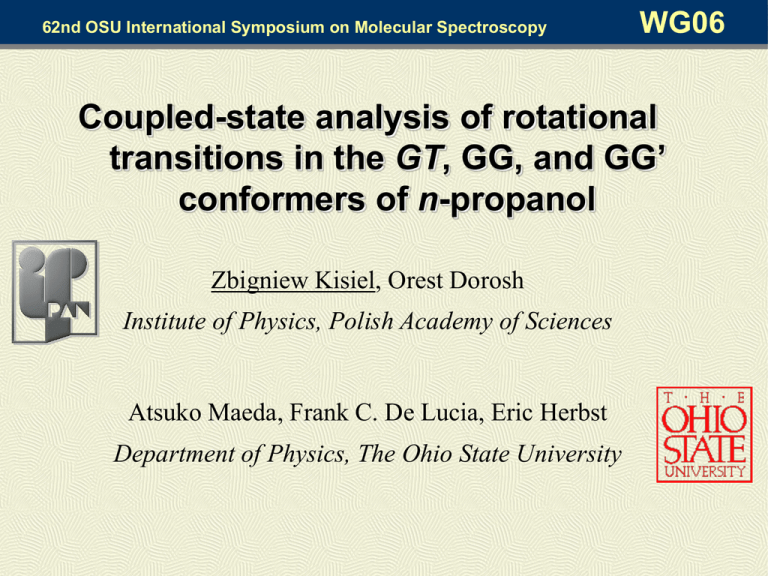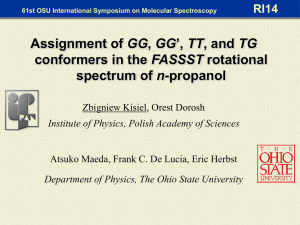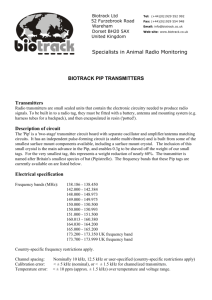Coupled-state analysis of rotational , GG, and GG’ GT n
advertisement

62nd OSU International Symposium on Molecular Spectroscopy WG06 Coupled-state analysis of rotational transitions in the GT, GG, and GG’ conformers of n-propanol Zbigniew Kisiel, Orest Dorosh Institute of Physics, Polish Academy of Sciences Atsuko Maeda, Frank C. De Lucia, Eric Herbst Department of Physics, The Ohio State University TT TG (two identical) Rotation of CH2OH about CC GT Rotation of OH about CO GG GG’ Most relevant previous studies: Abdurakhmanov et al. : several papers over the period 19671987, cm-wave rotational studies of n-propanol. gauche form estimated to be the most stable one. Maeda et al. , Astrophys. J. Suppl. Ser. 162, 428 (2006): over 2400 lines of the GT conformer up to 375 GHz assigned and fitted Kahn & Bruice, Chem.Phys.Chem. 6, 487 (2005): detailed ab initio analysis of relative energies. In the preferred result GT is the global minimum with GG, GG’ at 38, 52 cm-1, resp. TT,TG are at 28,45 cm-1, resp. Present authors, RI14, 61st OSU Symposium: assignment of GG and GG’ conformers on the basis of bands spotted in the FASSST spectrum, using the AABS package. Preliminary analysis in terms of a two state GG GG’ fit. Noted deficiency of the GT fit A.Maeda, et al., Astrophys. J. Suppl. Ser. 162, 428 (2006) 17 15 Ka= 19 16 18 Distribution plot of obs-calc values for the GT conformer symbol size is proportional to the magnitude of obs-calc. Red circles are for obs-calc > 0.3 MHz and do not increase above o-c>0.7 MHz Calculated spectroscopic observables for n-propanol: A* B C /MHz DJ /kHz DJK DK dJ dK GT GG 14339 5102 4307 14100 5019 4280 GG’ 14216 5034 4227 TT 26579 3784 3531 TG 26147 3734 3508 5.40 -23.8 64.1 1.59 11.9 5.09 -21.7 58.4 1.43 10.1 5.54 -25.9 69.6 1.65 11.2 m_a /D m_b m_c 0.71 0.87 0.96 0.56 1.04 1.09 1.39 0.12 0.87 0.09 1.46 0 1.15 0.39 1.15 m_tot 1.48 1.61 1.65 1.46 1.68 E** /cm-1 0 38 52 * Unscaled B3LYP/6-31G(d,p) **Kahn & Bruice, Chem.Phys.Chem. 6, 487 (2005) 0.828 -2.35 58.7 0.0737 0.361 28 0.840 -2.61 57.6 0.0737 1.10 45 Confirmation of the assignment of the GT conformer GT g.s. A B C /MHz DJ /kHz DJK DK dJ dK N s /kHz 14330.37308(45) 5119.30843(16) 4324.20213(16) 5.66401(22) -24.6960(11) 67.8861(38) 1.687806(53) 12.56606(88) 2861 63.1 * Unscaled B3LYP/6-31G(d,p) =1 14378.5960(21) 5104.59867(93) 4318.31841(57) 5.74650(85) -26.4520(35) 75.088(12) 1.71737(36) 13.027(14) 308 83.1 calculated* 14339 5102 4307 5.40 -23.8 64.1 1.59 11.9 Cavity-FTMW Stark measurements for GT n-propanol Band A: J = 17 16 of GG’ Band C: Ka = 9 8 cQ+bQ of GG (white left), GG’ (white right), GT (yellow right) Data set distribution plot for separate GT and GGGG’ fits obs-calc differences are plotted with symbol size proportional to the magnitude of the difference. Red circles are for obs-calc > 0.3 MHz Data set distribution plot for three state GTGGGG’ fit obs-calc differences are plotted with symbol size proportional to the magnitude of the difference. Red circles are for obs-calc > 0.3 MHz Principal terms in the Hamiltonian Choice made along the lines used for ethanol, Pearson,Sastry,Herbst,De Lucia , J. Mol. Spectrosc. 175, 246-261 (1996) with account for change from Cs to C1 symmetry. H = Hrot(gt ) (Fac + …)(Pa Pc + Pc Pa) + (Fab + …)(Pa Pb + Pb Pa) (Fac + …)(Pa Pc + Pc Pa) + (Fab + …)(Pa Pb + Pb Pa) Hrot(gg ) + DE(gg-gt) (Fbc + …)(Pb Pc + Pc Pb) + (Fab + …)(Pa Pb + Pb Pa) (Ga + GaJ + GaK+…)Pa+ (Gb + GbJ + GbK+…)Pb+ (Gc + GcJ + GcK+…)Pc (Fbc + …)(Pb Pc + Pc Pb) + (Fab + …)(Pa Pb + Pb Pa) (Ga + GaJ + GaK+…)Pa+ (Gb + GbJ + GbK+…)Pb+ (Gc + GcJ + GcK+…)Pc Hrot(gg’ ) + DE(gg’-gg) GT GG GG’ Evidence for the magnitude of DE (GG-GT) GT Ka=1918 Q-branch DE (GG-GT) = 47.8 cm-1 Ka=1514 Q-branch GG Three state ( GT GG GG’) fit n-propanol: GT A /MHz B /MHz C /MHz DJ DJK DK dJ dK /kHz /kHz /kHz /kHz /kHz HJ HJK HKJ HK hJ hJK hK /Hz /Hz /Hz /Hz /Hz /Hz /Hz 14330.37224(40) 5119.30723(14) 4324.20337(15) GG 14207.302(16) 14257.477(16) 5036.43195(34) 5051.10933(40) 4290.1090(17) 4253.8584(17) 5.66005(27) -26.543(30) 69.710(30) 1.687508(26) 12.051(23) total lines distinct fr.lines 5.33520(33) -23.5239(70) 61.469(51) 1.49720(11) 11.775(13) -0.000008(34) 0.0694(27) -1.396(16) 2.574(18) 0.0009639(71) -0.1042(16) -0.648(25) E /MHz -1433902.9(82) E /cm-1 47.82985(27) = 8340 = 6475 GG' 5.25074(44) -21.156(29) 67.699(59) 1.56169(22) 11.521(26) 0.00213(12) 0.2295(36) -1.796(14) 2.670(39) 0.006746(47) -0.1530(38) 1.645(69) 0.0 0.0 micr rms /kHz RMS error 0.00757(14) -0.0664(69) 0.625(31) 0.660(52) -0.002187(81) 0.0492(54) -1.46(11) 90989.129(81) 3.0350707(27) 83.5 0.848 Interaction constants in the ( GT GG GG’) fit x = a x = b x = c GG-GG’: Gx GxJ GxK GxJJ GxJK GxKK /MHz /MHz /MHz /kHz /kHz /kHz 588.7(14) -0.06567(50) -0.1274(64) 0.02741(74) -0.083(12) 0.094(60) 537.2363(90) -0.029655(12) -0.06133(55) 0.0007288(47) -0.00665(58) [ 0.] 96.90(95) -0.01148(65) 0.538(43) 0.005315(33) -0.10673(86) [ 0.] GT-GG: Fx /MHz [0] 6.24(40) 10.89(11) GT-GG’: Fx FxJ FxK /MHz /MHz /MHz 5.408(69) [ 0.] -35.33(37) 0.000731(34) 0.00795(25) A total of 76 fitted constants = 3 x 15 in Hrot + 2 x DE + 29 in Hint Jmax = 62, Kmax = 33 Comparison with ethanol 45 14 3.035 071(3) cm-1 GG’ 90989.129(81) GG 38 47.829 9(3) cm-1 GT J.C.Pearson, et al., J. Mol. Spectrosc. 175, 246 (1996) This work Calc /cm-1 Principal conclusions: A plausible three state fit is reported for the GTGGGG’ conformers of n-propanol The fit encompasses over 6400 distinct frequency lines measured in the three states, at a satisfactorily overall deviation of fit of 85 kHz, and for Jmax = 62, Kmax = 33. The main result is DE(GG - GT) = 47.829 9(3) cm-1 DE(GG’- GG) = 3.035 071(3) cm-1 and it constitutes a precise benchmark for ab initio, from which the best current values are 38 and 14 cm-1, respectively. In the second series, consisting of TT, TG+ and TG– conformers, the vibrational energies are closer to each other than T, G+ and G– in ethanol and the fit still poses a considerable challenge…


